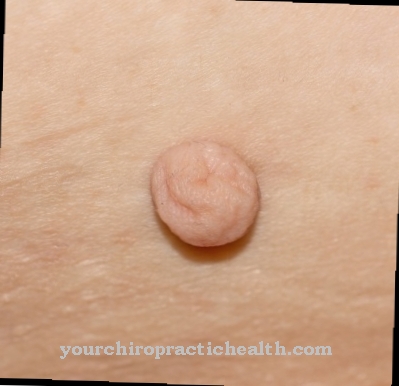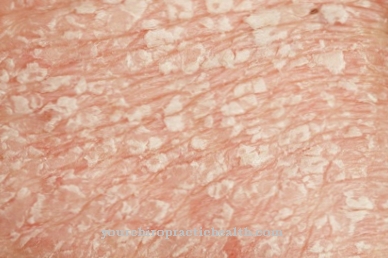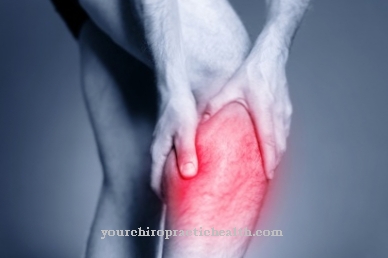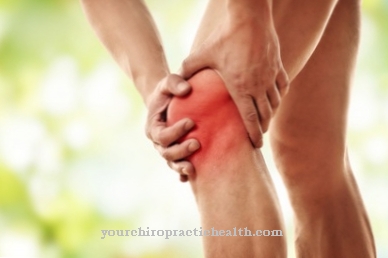Calluses are firm bumps in the skin caused by pressure and friction. Due to the increased stress, calluses are particularly common on the feet, often triggered by pressing, poorly fitting shoes.
What are calluses?

Calluses are solid areas of the skin that have become relatively thick in relation to the surrounding areas, mostly caused by friction, pressure or other irritations.
Short, intense rubbing usually causes blisters to form on the skin. However, constant pressure over a long period of time causes calluses. Frequent walking in tight, oppressive shoes causes calluses, especially on the feet.
In the vast majority of cases, calluses are not dangerous, but rather annoying and more of a cosmetic problem. The dry areas of the skin can, however, tear open and thus be susceptible to bacteria and consequently to infections.
causes
Calluses are basically a natural defense reaction of the body. With increased use and stress on individual areas of the skin, these develop a thicker layer to counteract the stress.
Some calluses on the feet are caused by incorrect foot positioning, which over time increases pressure on certain areas. In most cases, however, the cause is poorly fitting shoe. Calluses, especially women's shoes with high heels. They shift the pressure forward on the toes. This means that women are four times more susceptible to foot problems than men.
Another cause of calluses is wearing shoes without socks. The foot has less grip and the risk of friction increases. Rapidly growing bumps are often mistaken for calluses. Warts can form just as quickly or splinters can become infected in the skin, especially in children. These problems require special treatment.
Diseases with this symptom
- Corns
- Hallux rigidus
- Hallux valgus
Diagnosis & course
In most cases, calluses aren't difficult to spot. The person concerned will notice pressure and discomfort himself and thus be able to associate the thickening of the skin on the affected areas with it.
Apart from the visible and tangible elevation of the skin, the calluses can be recognized by their hardness. The skin is much firmer there. There are also mostly differences in skin color. Calluses can be either a little lighter or darker than the rest of the skin. It is also more prone to drought, may peel off faster or develop cracks.
When walking or running, pain often occurs in the affected areas due to increased pressure. A doctor should be seen if the callus ruptures and bleeds or leaks other fluid.
Complications
Complications associated with calluses are relatively rare as calluses are a harmless and common symptom. Since calluses are caused by pressure or excessive stress, the top layer of skin becomes thickened. In rare cases, they can cause inflammation.
This happens when the top layer of skin breaks open and the wound becomes contaminated. In such a case, bacteria lodge in the open wound and inflammation develops. In very special cases, pus can also form. With such a clinical picture, a visit to the doctor is essential.
Such an inflammation can, however, be brought under control very quickly with appropriate medication. Another complication that can occur is fungal infection. The result is a very unpleasant odor and severe pain when resting. Even in such a case, the open callus must be treated with appropriate medication.
Otherwise, other complications such as blood poisoning can occur.Further inflammation of the fungal infection is also possible if the affected areas are not clean and kept pure.
When should you go to the doctor?
At first glance, a callus is not a worrying clinical picture that must be treated or examined by a doctor. A callus is caused by excessive stress on an area of the skin. This usually disappears on its own after a certain time. Under certain circumstances, however, complications can arise that must be treated by a doctor. Anyone who generally suffers from dry and brittle skin is prone to developing cracks. A crack is a deep crack in the skin that cannot grow back together on its own.
If a callus continues to be stressed, it can under certain circumstances develop into a crack. Due to the dry skin, the deep skin crack does not grow back together by itself. A visit to the doctor is inevitable in such a case. If you forego a visit to the doctor in such a case, you run a great risk. A deep crack in the skin provides bacteria with the best conditions to multiply. There is therefore a risk of severe inflammation which, in the worst case, can even cause blood poisoning. If you want to avoid such complications early on, you shouldn't put off a visit to the doctor. With appropriate creams or ointments, calluses can be treated quickly and effectively.
Doctors & therapists in your area
Treatment & Therapy
Most calluses slowly recede once pressure is released on the affected area. The doctor may remove an upper layer of the cornea to reduce the thickness and thus the pressure. There are pressure-reducing plasters or solutions that slowly remove the thick layers of skin. But these are not suitable for everyone.
Moisturizing creams can be used to treat very dry calluses to make them easier to peel off and to reduce the risk of cracking. The affected area should be well anointed and then protected with a plastic bag or sock for an hour. However, such treatments should be discussed with the dermatologist.
The calluses can be rubbed slowly and carefully with special brushes or stones. This is easier after showering or bathing. Mistakes can also quickly occur when treating with moisturizers. The area between the toes is particularly susceptible to moisture and thus to fungi and infections.
Those affected should take care to keep these areas sufficiently dry during treatment. Calluses can also be removed surgically. If they are the cause of a deformity, orthopedic measures can provide relief.
Outlook & forecast
Calluses usually result from excessive stress on the area in question. An exact prognosis or an explicit course is therefore dependent on the intensity of the further exposure.
If a callus has already developed, it should heal by itself after a certain period of rest. A callus heals within a week even without medical or drug treatment. However, if the respective area is further stressed, an open wound can develop from a callus. The open wound can then become infected and, under certain circumstances, pus can also develop. If such a clinical picture is not treated by a doctor within a very short period of time, there is a risk of blood poisoning. This can have serious consequences that can lead to death.
However, such inflammation can be combated very well with appropriate treatment. So after a few days you should see a clear improvement. Therefore, if a callus is not further stressed, the course of the disease can be expected to be very harmless. The affected area regenerates so that a new layer of skin can develop.
prevention
Home remedies ↵ for calluses Well-fitting, comfortable footwear is the best prevention against Calluses on the feet. However, calluses are triggered all over the body by increased pressure. If this is avoided, ugly and painful calluses will not develop.
You can do that yourself
Calluses can have very different causes and occur in different parts of the body. These factors determine what those affected can do about squint themselves.
Calluses on the palms of the hands and fingertips usually result from recurring physical exertion. Anyone who, such as craftsmen, regularly performs heavy work with their hands should observe certain precautionary measures. Protective gloves not only protect against cuts and scratches, they also help prevent calluses. It is important that the gloves are made of a breathable material. Rubber gloves, however, usually promote the development of calluses. It is also important to take care of the affected areas of the skin. The hands should be cleaned regularly with a mild syndet and then rubbed with a nourishing, moisturizing ointment to prevent the formation of calluses.
Existing calluses should first be carefully rubbed with a pumice stone to remove the callus, and then treated with a special ointment from the pharmacy. In naturopathy, marigold ointment is recommended. This procedure is also generally recommended for calluses on the feet. If these are very painful, padding with special plasters can provide relief. Calluses on the feet are also very often due to the wrong footwear. Tight, pointed or high shoes should generally not be worn or only very rarely.




.jpg)



















.jpg)



